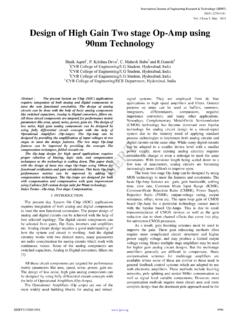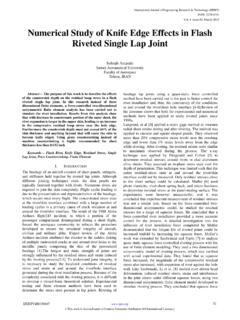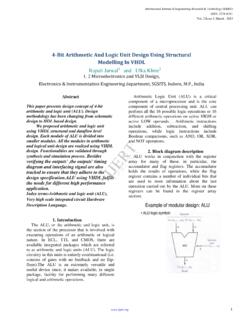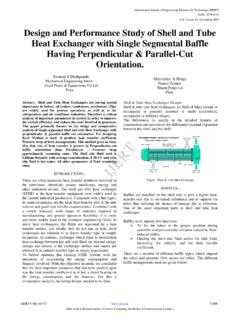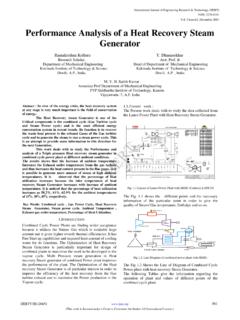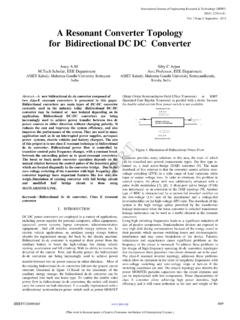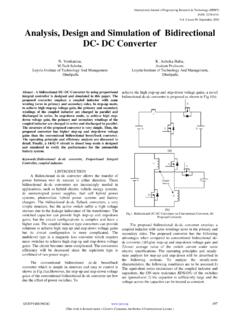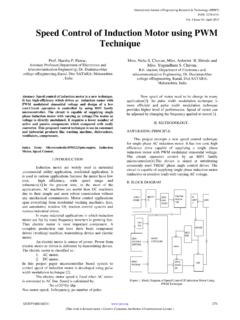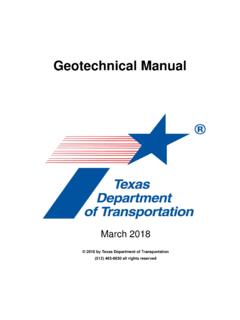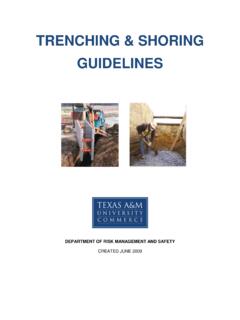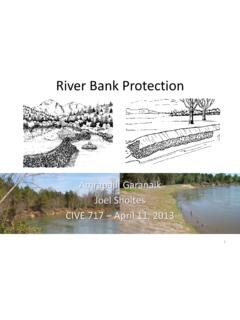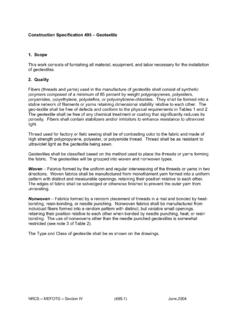Transcription of An Overview on Methods for Slope Stability Analysis - IJERT
1 An Overview on Methods for Slope Stability Analysis Mr. Digvijay P. Salunkhe Assist. Prof. Guruprasd Chvan T E. Civil, Department of Civil Engineering Department of Civil Engineering KIT'S College of Engineering, KIT'S College of Engineering, Kolhapur, India. Kolhapur, India. Ms. Rupa N. Bartakke, Ms. Pooja R Kothavale Civil, Department of Civil Engineering Civil, Department of Civil Engineering KIT'S College of Engineering, KIT'S College of Engineering, Kolhapur, India. Kolhapur, India. Abstract: The Analysis of Slope Stability has received widely attention now days because of its practical importance. To provide steepest slops which are stable and safe various investigations are ongoing.
2 Stability is determined by the balance of shear stress and shear strength. If the forces available to resist movement are greater than the forces driving movement, the Slope is considered stable. A factor of safety is calculated by dividing the forces resisting movement by the forces driving movement. A previously stable Slope may be initially affected by preparatory factors, making the Slope conditionally unstable. The field of Slope Stability encompasses static and dynamic Stability of slopes of earth and rock-fill dams, slopes of embankments, excavated slopes, and natural slopes in soil and soft rock. Various Methods are available for Slope Stability Analysis . This paper aims an Overview on various Methods of Slope Stability on the basis of assumptions, Factor of safety calculation, soil conditions, soil types, applicability of output of the method with its limitations.
3 This paper also aims to focus some new mathematical tools which can be applicable for Stability Analysis of Slope . I. INTRODUCTION A Slope is defined as a surface of which one end or side is at higher level than another; a rising or falling surface. An earth Slope is an un supported, inclined surface of a soil mass. The failure of a mass of soil located beneath a Slope is called as slide. It involves a downward and outward movement of the entire mass of soil that participates in the failure. The failure of slopes takes place mainly due to, The action of gravitational forces, and Seepage forces within the soil . They may also fail due to excavation or undercutting of its foot, or due to gradual disintegration of the structure of the soil .
4 Slides may occur in almost every conceivable manner, slowly or suddenly, and with or without any apparent provocation. Slope Stability Analysis is performed to assess the safe design of a human- made or natural slopes and the equilibrium conditions. Slope is the resistance of inclined surface to failure by sliding or collapsing. The failure of a Slope may lead to loss of life and property. It is therefore, essential to check the Stability of proposed slopes. With the development of modern method of testing of soils and Stability Analysis , a safe and economical design of Slope is possible. The geotechnical engineer should have a thorough knowledge of the various Methods for checking the Stability of slopes and their limitations.
5 A. The main types of Slope are the: 1. Infinite Slope : if a Slope represents boundary surface of a semi infinite soil mass and the soil properties for all identical depths below the surface are constant is called as infinite Slope . 2. Finite Slope : if the Slope is of limited extent it is called as finite Slope . B. Application: 1. It is used to road cuts, open-pit mining, excavations, and landfills. 2. It is used to earthen dam. 3. It is also used to railway formation, highway embankment, canal bank, levees etc. 4. It is used to deep-seated failure of foundations and retaining walls. C. Methods of construction: The conventional method is used for the Slope construction in that first earth soil laid on the surface.
6 After that roller is applied on surface of the earth soil , for the compaction of soil . Before, all this procedure some test are required such as OMC (optimum moisture content), dry density using proctor test or modified proctor test Methods . International Journal of Engineering Research & Technology ( IJERT )ISSN: 2278-0181 (This work is licensed under a Creative Commons Attribution International License.)Published by 6 Issue 03, March-2017528D. Methods for Analysis : 1. Limit equilibrium: a. Analytical technique- Methods of slices Swedish slip circle method of Analysis Ordinary method of slices Modified bishop s method of Analysis Lorimar s method of Analysis Spencer s method of Analysis Sarma method of Analysis Taylors Stability number 2.
7 Finite element method: The probabilistic FE method: Perturbation Method Monte Carlo simulation and Direct Coupling Approach. 3. Numerical method of modeling: Continuum modeling Discontinuum modeling Hybrid/coupled modeling II. LITERATURE REVIEW 1. Carol Matthews and Zeena Farook, Arup; And Peter Helm (2014): Was published Slope Stability Analysis limits equilibrium or the finite element method . They concluded that, as computers and their application evolve in geotechnical Analysis ; it seems that we should be looking to more advanced ways to analyses Slope Stability . This study has shown that there are significant opportunities in using the more comprehensive finite element Analysis . However, the traditional Limit Equilibrium method remains able to produce accurate and reliable results.
8 The both have their advantage sand disadvantages with the choice of which method to use depending on some of the considerations described below the method the user selects should be based on the complexity of the problem to be modeled. For example problems with complex geometries or that requires Analysis of seepage, consolidation and other coupled hydrological and mechanical behavior (pore water pressure induced with more complex mechanical soil responses ( post failure strain softening and progressive failure) may be better tackled using FE Analysis . 2. Khaled Farah, Mounir Ltifi And Hedi Hassis (2015): were published A Study of Probabilistic FEMs for a Slope Reliability Analysis Using the Stress Fields.)
9 In this paper, they were concluded the perturbation method and the spectral stochastic finite element method (SSFEM) using random field theory are presented. These Methods are applied to analyze the Stability of a homogeneous Slope assuming an elastic soil behavior. To overcome the absence of the analytical solution of the mean and standard deviation of the factor of safety, the Monte Carlo simulation combined with the deterministic finite element code is applied. In fact, the perturbation method provides satisfactory results and it is easy to apply even with high random field expansion order. 3. Bozana Bacicn (2014): Slope Stability Analysis in that paper they conclude a methodology of Slope Stability Analysis and provide an insight into the basic of landslides and their general terms.
10 Natural process of constant affected by change in relationship for shearing stress and resistance. 4. A. Burman, S. P. Acharya etc. all (2015): Comparative study of Slope Stability Analysis using traditional limit equilibrium method and finite element method In that they concluded that present work, limit equilibrium technique (ordinary slice method, Bishop s method, Spencer s method, Morgenstern-Price method) and finite element method have been used to the study different Slope Stability problems. Also, it is observed that ordinary slice method provides most conservative estimation of factor of safety values amongst all the limit equilibrium techniques considered in this paper.

